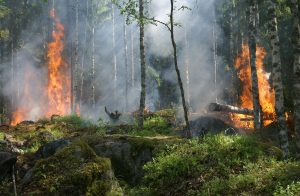Australians enjoy winning against the odds, but we must move quickly to slow global warming and the intense weather it creates
With the constant climate change, Australia is predicted to face more intense weather.
“Unprecedented” is the word that keeps being connected into the apocalyptic weather Australia has faced over the last few months.
Bushfires have always been a factor in Australia, but it has never grown to this scale with such widespread harm. It is estimated that over 60,000km² have been scorched in New South Wales and Victoria alone.
Smoke and smog have shrouded Sydney, Canberra and Melbourne for days. And following the fires, flooding in the weekend in NSW and parts of Queensland left thousands without electricity, and dozens of colleges closed on Monday.
While Australia is still grappling with the economic reality and human devastation caused by the fires, it’s easy to think the worst of the disaster is over. But unfortunately, other extreme weather may nevertheless occur this summer, and these will also require security preparations and quick responses.
Flash floods
2019 was the driest and hottest year ever recorded in Australia. Some areas of the country have experienced several years of drought in a row. But all droughts end finally. On the weekend, catastrophic storms swept through southern NSW and caused major damage, including flooding, power outages and general chaos.
391.6mm of rain fell over Sydney in the last four days, the most since 414.2mm dropped in 1990.
Historically Australian continental-scale droughts are often broken by widespread heavy rain, resulting in an increased risk of flooding, such as potentially deadly flash flooding.
The flooding threat from the heavy rains is exacerbated by bare soil and lack of vegetation due to the drought and by bushfires that destroy forest and grassland.
When a decade-long drought ended in 2009, what followed were two extremely wet years with severe flooding. Flooding also brings the threat that ash might contaminate water supplies. The heavy rain falling on bare soil may also result in severe erosion.
Tropical cyclones
The beginning of the tropical wet season over northern Australia has been very much delayed, as predicted amid last year from the Bureau of Meteorology.
The majority of the Australian tropics have experienced below-average rainfall in the last few months, and some regions had their lowest November-January rain.
At the same time, the tropical cyclone season was late, also called by the agency months ago. In recent weeks there’s been some cyclone action and some rain. However, the wait is still on for widespread tropical rains and for more cyclones to cross the shore as Cyclone Damien did in the weekend. Although rain caused by storms tend to be welcome, they may also leave critical damage.
Southern heatwaves
 We’re in the riskiest time for heatwaves in southern Australia. The danger usually peaks around the middle to the end of summer. Weather conducive to increased bushfire danger also generally peaks in February for southern countries.
We’re in the riskiest time for heatwaves in southern Australia. The danger usually peaks around the middle to the end of summer. Weather conducive to increased bushfire danger also generally peaks in February for southern countries.
So although media, political and community attention have focused on the horrendous bushfires we’ve already endured, we should not forget about the chances of additional extreme weather, such as cyclones, floods and heatwaves, or believe that the bushfire threat is over for the year.
It’s important to stay vigilant for all weather conditions.
How to Prepare
If you suspect that you or someone you know will be affected by the fires of floods, you can get professional first aid training to best prepare for emergency situations. Furthermore, if you are employed in a workplace that you suspect to be in the danger zone of fires and floods, you can also speak with safety consultants to generate a risk assessment plan and emergency protocol to keep you and your workers safe.
You can check whether you are in or near a danger zone by using satellite imagine provided by the government.